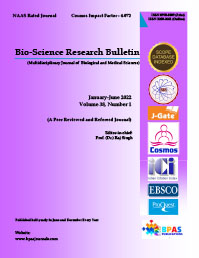A Medical Briefing on the p53 Tumour Suppressor Gene
DOI:
https://doi.org/10.48165/Keywords:
Metastasis, Homeostasis, P53, Growth Phases, Cisplatin, Calcium, Fractions, LocomotionAbstract
The p53 tumour suppressor gene is a sequence of nucleic acids that play an important role in growth and metastasis in human tissues (Singh, 2019). This sequence of nucleic acids is vital in human life, as rubisco is to C3 and C4 plants (Singh, 2019). In mammals, p53 determines the ultimate lifespan of a cell. This means that in order to make tissues, which eventually go to make organs, a regulated sequence of nucleic acids is necessary in order to prevent unwanted necrosis from happening. This implies that the p53 gene has medical implications if it is not regulated during mitosis, and, thus also meiosis, in cells (Shaw, 1996). However, although tissue stasis is controlled by the p53 suppressor gene, in predicting cells, its role is less prominent. This doesn’t mean that p53 isn’t active in the latter situation, instead, this means that p53 is active in promoting cell death events in other tissues (Giono and Manfredi, 2006). This has dire medical consequences in that p53 nucleic acid sequences I its natural state doesn’t necessarily promote cell cycle events. This is because a dysfunction in p53 tumour suppressor genes could be a result of point mutations. It’s possible for this to be done if a person is taking drugs or medication prescribed for treating a medical condition (Singh, 2019). This is true in patients who have life-threatening ailments like cancer, tuberculosis and HIV (Singh, 2019). In these patients this is the case because of the immune-compromised state of the host, but more so because of serum-circulating drug concentrations (Singh, 2019). This means the p53 gene mutations can in fact promote cell death in healthy tissues. This is a major medicinal problem. However, although medical interventions are in place, the role of the p53 tumour suppressor gene will remain unaltered (Agarwal et al., 1995; Chen, no year supplied). In breast cancer, for example, the cells are in a constant state of growth in untreated patients. This is the case because, here, the p53 tumour suppressor gene promotes rapid growth of cancer through the 4 stages (Wang et al, no date supplied). In all human cells, the p53 tumour suppressor gene is central in cell cycle events. This is a discovered fact because without p53 it has been found that human systems would be dysfunctional. Tis gene enables human cells to pass through growth phase 1 and 2, separated by respiration events. This means that p53 plays an important role in preventing tumour formation in human cells (Gordon et al., no year supplied; Shaw, 1996). In laryngeal cancer cells it has been found that p53 functioning depends largely on the introduction of substances. In the case of plant compounds / fractions, it has been found that a mixture of cell cycle events occurs. This has been attributed to solvents that induce cell proliferation and cell death at different intensities (Singh, 2019). Furthermore, in the case of signal transduction, it has been found that p53 tumour suppressor is, in fact, affected by cisplatin, a drug compound that affects the entry of calcium into and out of the cell. However, although the role of the p53 tumour suppressor gene shouldn’t be complicated, as it’s a known fact, its role is complicated by the ideas that its role in cell cycle events is to bring tissue homeostasis (Agarwal et al., 1995). However, its role is complicated because it affects the process of mitotic catastrophe. In mitotic catastrophe, p53 genes affect mitotic fibres involved in cell proliferation. This triggers events that instead of suppressing tumour growth, tumour persists and result in tumorigenesis, or carcinogenesis (Shaw, 1996). A remarkable feature of the p53 tumour suppressor gene, though, is to be able to regulate cell bodily functions, inducing those pertaining to movement and locomotion in mammals (Singh, 2019).
References
Singh, R. (2019). Personal writing and communication. Durban, Republic of South Africa. 2. Agarwal, M.L., Agarwal, A., Taylor, W.R., Stark, G.R. (1995). p53 controls both the G2/M and the G1 cell cycle checkpoints and mediates reversible growth arrest in human fibroblasts. Proc of the National Academy of Sciences of the United States of America.
Chen, J. (2016). The Cell-Cycle Arrest and Apoptotic Functions of p53 in Tumor Initiation and Progression. Cold Spring Harbor perspectives in medicine, 6(3), a026104. https://doi.org/10.1101/cshperspect.a026104
Shaw, P.H. (1996). The role of p53 in cell cycle regulation. Pathology-Research and Practice V. 192 (7), 669-675. DOI: 10.1016/s0344-0338(96)800088-4.
Giono, L. E., Manfredi, J. S. (2006). The p53 tumour suppressor participates in multiple cell cycle checkpoints. Journal of Cell Physiology, 209, 13-20.
Wang, S., Wafik, S. and Deiry, E.I. (2005). Cell cycle arrest and apoptosis (chapter 6). P. Hainant, K G Wiman (eds). 25 years P53 Research, 141-163. Springer.
Gordon E. M, Baricz, J. R., Seiga, L. M, Chaula, S. P. and Hull F. L. (2018). Cell cycle checkpoint control: The cyclin G1/Mdm2/p53 axis emerges as a strategies target for board spectrum cancer gene therapy – A review of molecular mechanisms for oncologists. Molecular and Clinical Oncology, 9(2), 115-134.
